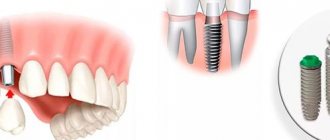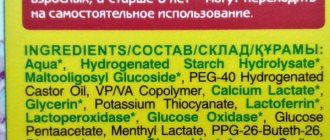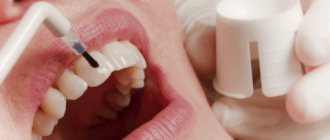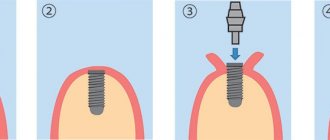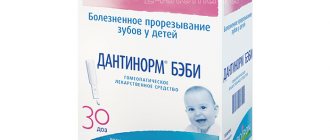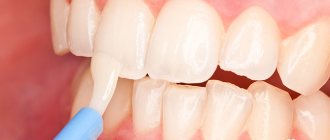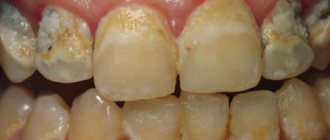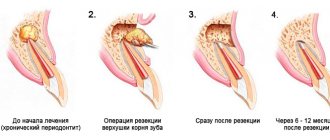The main minerals in the natural enamel coating of a tooth are calcium and fluoride. A deficiency of these substances causes thinning and destruction of the enamel, which leads to its darkening and the appearance of microcracks on its surface, into which bacteria penetrate, subsequently causing the development of caries. Sometimes a lack of minerals leads to the tooth surface becoming unpleasantly uneven or rough.
The process of leaching calcium and fluoride from dentin is designated by a special medical term - “demineralization” and is widespread in modern society. Almost 80% of the adult population of our planet faces a lack of important minerals in dental tissues. It is quite possible to stop the process of dentin demineralization and enamel destruction - you need to contact our dentistry in Moscow and undergo a dental fluoridation procedure.
Indications for the fluoridation procedure are as follows:
1. Thinning and destruction of the natural enamel layer of teeth.
2. Prevention of caries.
3. Increased sensitivity of teeth.
4. Increasing the useful life of already installed fillings.
However, it is worth knowing that fluoridation, like any other dental procedure, has not only indications for implementation, but also contraindications. In particular, manipulations to saturate dental tissue with fluoride cannot be carried out if there is an individual intolerance to the active substances contained in fluoridating compounds, hypersensitivity to odors and tastes, as well as epidemic fluorosis.
Attention! Not only a deficiency of minerals is harmful to the body, but also an excess of them, and therefore, after fluoridation of teeth, you should not use pastes and rinses containing fluoride in oral care.
Fluoridation of teeth
from 1500 rub. More about prices
We have been working since 1994
we are one of the first to open private dentistry in Moscow
Best materials
only new and modern equipment for dental treatment
Free
consultation with a dentist
Payment options
- cash
- plastic cards
- cashless payments
Doctors' experience
- with great experience
- graduated
- conference participants
Simple fluoridation of teeth
Simple fluoridation of teeth is a popular and most frequently performed procedure in modern dentistry. This method of dentin remineralization is painless and does not cause discomfort to the patient, except in cases where the patient has an increased sensitivity to fluoride-containing medications.
Simple fluoridation can be carried out in two ways:
1. Using individual aligners. During the first dental visit, the dentist examines the patient and takes an impression of his teeth, from which the mouth guards are then made. The recesses in the aligners are filled with fluoride gel, and then the wax structure is placed over the teeth for 15 minutes. The procedure is repeated about 10-15 times.
2. Using fluoridating varnish. The drug is applied to the surface of the teeth manually, with a brush, and it is extremely important to ensure that the substance does not get on the mucous membrane or gum tissue. The number of procedures to achieve the most pronounced result is 3-4.
Simple fluoridation of teeth differs from deep fluoridation in that the mineral during manipulation does not penetrate deeply into the enamel coating and dentin, but simply forms a dense protective film on the surface of the tooth, the integrity of which is maintained for 5-6 months, after which it is recommended to repeat the remineralization procedures.
Expert opinion of RAIDEN specialists
The fluoridation procedure is useful for the teeth of young patients, subject to indications for its implementation and taking into account contraindications. Fluoride is certainly useful for the formation of a growing organism. Its deficiency during the formation of the dental system can affect not only the health of the teeth, but also the entire body as a whole. Excess is also harmful. Therefore, the correct dosage of fluoride varnish during the procedure is an important point. Fluoridation “within reasonable limits” is a means of avoiding more complex, expensive and painful treatment. It is better to prevent any disease than to treat it. Prices for dental fluoridation depend on the amount of work.
Stages of simple fluoridation
The simple fluoridation procedure consists of several successive steps:
- Before remineralization, the specialist must clean the surface of the teeth with a special brush and paste;
- The teeth are dried to prevent saliva from entering, and the oral cavity is tightly lined with cotton swabs;
- Fluoridation. A fluoride varnish is applied to the natural enamel coating of the tooth with a brush. If a gel is used in simple fluoridation, it is placed in mouthguards that are placed on the patient’s teeth for about a quarter of an hour.
- Repeated drying is necessary for complete drying of the fluoridating composition on the tooth surface.
Upon completion of the above-described manipulations, the doctor removes the cotton swabs from the oral cavity and advises the patient in detail on dental care after the procedure. After fluoridation, it is traditionally recommended not to eat for an hour. If varnish was used in remineralization, the next visit to the dentist is scheduled every other day, if the procedure was carried out with fluorine gel - after 10 days. It is recommended to do tooth replication in conjunction with the Air Flow teeth cleaning procedure.
Positive effect of fluoridation
- The procedure enhances the protection of milk and permanent teeth from caries.
- By strengthening the enamel and improving its density, MGs are not subject to destruction and are resistant to mechanical stress.
- The procedure is painless and the baby does not experience discomfort.
- After applying the composition, the incisors remain snow-white and do not darken.
- Sensitivity to cold, hot, sweet foods decreases.
- If fillings are treated with the substance, their service life increases.
- For prevention, the procedure is carried out 1-2 times a year.
Deep fluoridation of teeth
The procedure for deep fluoridation of teeth is a more complex process, but also more effective. Therapeutic procedures involve the use of special preparations that can seal tooth enamel and thereby protect it from thinning and destruction.
Two preparations are used to seal the enamel - calcium hydroxide and a composition saturated with copper, magnesium and fluorine. The active substances of the drugs react with each other to form crystals on the enamel surface of the tooth, which seal the enamel.
The compositions used in deep fluoridation contain ions of this mineral in extreme concentration, and therefore the positive result from remineralization will be maximally prolonged and persistent. The procedure is repeated no earlier than a year later. Another advantage of the method is that it uses a preparation containing calcium, and this makes it possible to further strengthen both the enamel coating and dentin of the teeth. It is recommended to perform tooth alignment together with the procedure of ultrasonic goiter cleaning.
Methods
The following methods are used for strengthening:
- the use of fluorine-containing compounds that penetrate deep into the tissues, protect dentin and pulp without being washed off for a long time;
- shallow simple fluoridation followed by application of fluoride varnish;
- deep treatment with tissue protection from serious damage, recommended until a permanent bite appears, carried out using special trays made from individual impressions;
- electrophoresis with the penetration of the drug through current, the procedure is highly effective, but has some contraindications.
Stages of the procedure
To perform strengthening, the following steps are used:
- preliminary examination, identification of indications;
- choosing a method, cleaning from plaque and stones;
- taking impressions, making trays for using gel;
- each manipulation lasts about ten to fifteen minutes, in total the course includes up to 15 such procedures;
- After completing the course, fluoride varnish is applied to the enamel and dried using a lamp.
This technique is recommended every six months; increasing the frequency is not recommended. If the dentist chooses deep fluoridation, a composition with an increased volume of the element is selected. During the appointment, the doctor performs the following actions:
- cleaning from plaque;
- drying the enamel, applying compositions with magnesium and calcium fluoride;
- repeated drying with treatment of the preparation based on calcium hydroxide.
Alternative
Some of the options for processing enamel for the purpose of strengthening are:
- Use of fluoride-containing pastes. The use of such products is necessary daily; pastes are selected individually during examination by a doctor. Regular use of fluoride-containing pastes eliminates the risk of developing caries and eliminates minor defects.
- Gel treatment. The use of such products is recommended after cleansing the surface of saliva and deposits. Next, the gel is applied to the enamel, left on for three to four minutes, and then washed off. The procedure is carried out several times a year, the duration of each course is determined by the condition of the tissues. You must first consult with the supervising dentist, who will select the drug, conduct a course of strengthening and monitor the results achieved.
- Use of rinse aids. Such products not only strengthen, but also clean the surface of the row and eliminate food residues. It is recommended to give solutions during the eruption of permanent teeth, while ensuring that the child does not swallow the mouthwash and use it after brushing and eating.
- Tablets. If there is a lack of fluoride in food or water, your dentist may prescribe sodium fluoride tablets. Such drugs can be given as early as two years of age; they compensate for the deficiency of the element and promote the normal development of milk elements.
About Us
My Ort Dental Clinic offers painless treatment for dental problems in children. The procedure is performed quickly, with anesthesia and is carried out for the little Patient in comfortable conditions. By contacting us, you receive the following benefits:
- modern, fully equipped offices;
- qualified doctors;
- complex treatment;
- favorable price for deep fluoridation for children.
You can visit us for a consultation examination or therapy at the address: St. Petersburg, st. Yesenina, 1, building 1. We work seven days a week, you can make an appointment using a special form on the website or by phone.
Stages of deep fluoridation
Deep fluoridation is also carried out in several stages:
- At the preparatory stage, teeth are cleaned with ultrasound. Not only plaque, but also tartar is removed from their surface;
- The tooth surface is thoroughly dried from saliva;
- Fluoridation is divided into two stages. The teeth are first coated with one compound, dried, and only after that the doctor treats the dental surfaces with preparation No. 2.
The doctor tells the patient about the peculiarities of dental care after deep fluoridation upon completion of all medical procedures.
Indications and contraindications
Deep fluoridation can be carried out from early childhood (from one and a half years). Contraindications
minimum:
|
|
Indications
There is much more to applying the method:
|
|
|
|
|
|
Advantages and disadvantages
Dentists who carry out the deep fluoridation procedure note that the technique has both advantages and disadvantages.
| Advantages | Flaws |
| High effectiveness , which consists in strengthening the enamel, reducing tooth sensitivity, preventing the risk of developing caries, and increasing the service life of installed fillings. | The development of fluorosis as a result of oversaturation of teeth with fluoride. |
| Duration of effect – fluoridation provides protection of the tooth surface for a period of six months to a year. | Fluoride intoxication if the technology for performing the procedure is not followed, which threatens the destruction of bone tissue, joint deformation and pathologies of the endocrine system. |
| Availability – the procedure is available at most dental clinics. | High cost of the procedure. |
| Painless, so no anesthetic is required. | |
| Versatility and a minimum number of contraindications, allowing manipulation for children and pregnant women. |
Fluoridation at home
There are several options for performing fluoridation at home: the use of drugs containing a chemical element and the use of medicinal pastes and rinses.
Special gels, preparations, fluoride varnish
Fluoride varnish is one of the preparations for home use.
Gels and varnishes for home use contain sodium fluoride, which forms a thin film on the enamel that protects teeth from damage and exposure to pathogenic microflora.
The drugs that can be used independently include: “Sensigel”, “Dental Resources Revive”, “Ftorlak”, “Topex 60 second fluoride Gel”.
These products can only be used after consultation with your doctor and in accordance with the manufacturer's instructions.
Be careful! Careless handling of fluoride-containing gels can lead to their contact with mucous membranes, which can lead to poisoning.
Pastes and rinses
One of the most popular means of prevention is the use of fluoride-containing pastes.
The fluorine content in therapeutic and prophylactic pastes of well-known brands reaches 0.14-0.15%. The dosage of the active element can range from 600-800 ppm in children's products to 1500 ppm in products for adults.
Popular pastes containing fluoride are: President Classic, Blend-a-med Complete, Colgate Elmex, El-ce med Total Care, Silca Herbal Complete.
The use of fluoride-containing rinses and elixirs, in addition to freshening breath, helps wash out the smallest particles of food from the interdental spaces and enrich the enamel with useful substances. Therapeutic and prophylactic rinses are present in the assortment of the brands “Lesnoy Balsam”, “Splat”, “Colgate”.
When is remineralization indicated?
Proper nutrition and oral hygiene are very important, but not always sufficient conditions for maintaining dental health. In order for prevention to be complete, remotherapy-remineralization should be carried out regularly. This procedure gives good results in restoring enamel after whitening. It is used as a preparatory stage before bleaching, but after hygiene. Remotherapy can be clinical or home (as prescribed by a doctor).
The procedure is also indicated for:
- large-scale anti-caries therapy;
- hypersensitivity;
- after removing braces;
- pregnancy.
